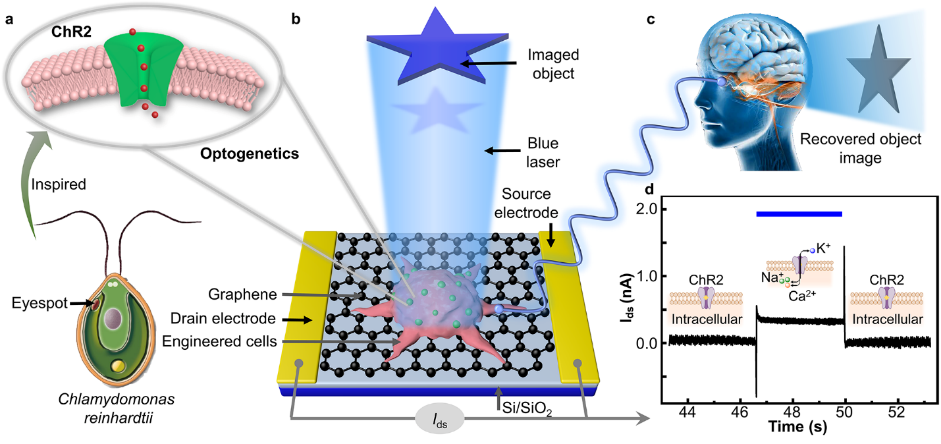
Bio-syncretic phototransistor based on optogenetically engineered living cells enables visual information transmission. (Image by SIACAS)
As the most important sensory system for human beings, visual systems acquire and process up to 80% of external information, and thus visual prostheses are critical for individuals suffering from blindness to regain functional vision. Imagine one day, biological cells being transplanted into humans as visual prostheses, which can be super exciting.
Integration of living visual elements into visual prosthesis design can inherit the merits of biological visual systems and enhance the overall biocompatibility of the visual prosthesis. However, the existing studies of photodetection using biological elements suffer from slow photoresponsivity and/or difficulty in imaging capability, and thus cannot satisfy the demand of visual perception. Relying on the capability of converting optical signals to bioelectrical signals, optogenetics sheds a light on developing bio-syncretic visual prostheses.
Researchers from Shenyang Institute of Automation, Chinese Academy of Science (SIACAS), collaborating with partners from Tsinghua University and University of Hong Kong, developed a novel bio-syncretic phototransistor with optogenetically engineered cells and a graphene-based structure for visual perception. The study was published online on Biosensors and Bioelectronics on 30 January 2021.
According to Jia YANG, first author of the paper, the joint team express photosensitive proteins, Channelrhodopsin-2 (ChR2) to be specific, on cell HEK293 and get the optogenetically engineered cells as core element of the bio-syncretic phototransistor. Control experiments show that the use of photosensitive proteins can largely enhance the photoelectric response and broaden the dynamic response range of the phototransistor.
Meanwhile, they use monolayer grapheme film to construct a non-destructive and high-throughput interface between the optogenetically engineered cells and a transistor-structured mechatronics system, realizing effective detection of the weak photoresponsive bioelectrical signals of the cells.
Experiments demonstrate that, the phototransistor owns excellent photoresponsive properties in comparison with the bioengineered photodetectors reported in the previous literatures. Besides, owing to the ultra-fast dynamics of the ChR2 variant E123A expressed on the cells, such phototransistor has a distinct advantage with respect to response time (~25 ms) and owns optical and biological gating with a significant large on/off ratio of 197.5 and high responsivity of 1.37 mA W-1. The time-saving, easy handling, and non-invasiveness phototransistor enables the direct use of biological components for visual perception.
“The study opens a new avenue in bionics investigations,” said Lianqing LIU, researcher from SIACAS, “Bionics research will not only involve a simple imitation of biological morphology or function, but also make full use of biological function by the integration of living materials and mechatronic systems.”
Contact:
Jia YANG
Email: yangjia@sia.cn